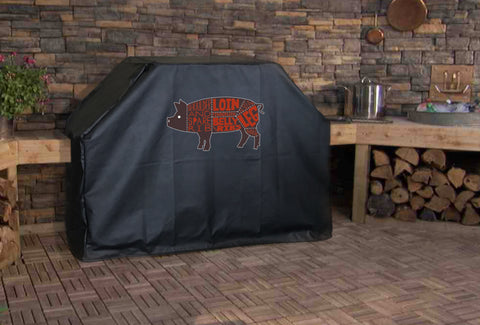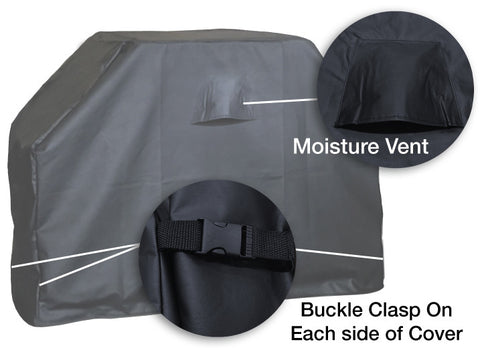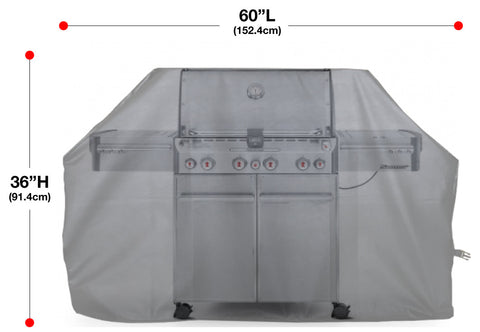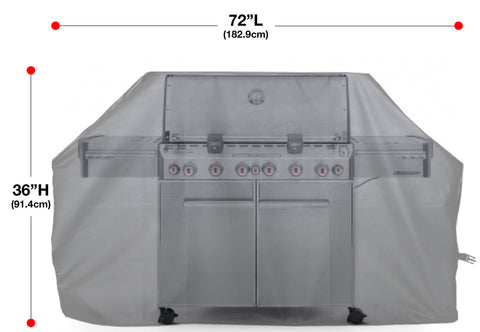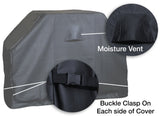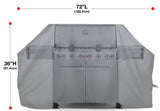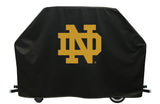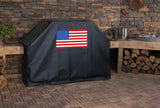- Home
- Grill Covers-Custom Grill Covers-Team Logo Grill Covers
- Pork Cuts Chart BBQ Grill Cover
Description:
Grill Cover with Pork Cuts Chart
Grill Cover Made From Commercial Quality Marine Grade Vinyl
Impress your friends, neighbors, and family with your Knowledge on the a Butcher's representation of a Pork Chart with all the cuts grill cover!
PORK SHOULDER, or PORK BUTT
Starting from the front of the pig: Pork shoulder (also called pork butt or “Boston butt”) is generally sold as a 5 to 10 pound boneless roast at the grocery store. (Pork shoulder chops are sold with bones, but those are less common.)
How to Cook: “It’s a really great thing to roast,” says Mylan. It’s a relatively tough cut, well layered with fat, and is good for braising, slow and low roasting or barbecue. “Shoulders are good for when you’re going to cook for a long period of time and want it to stay moist,” he says. A typical preparation? Pulled pork.
PICNIC HAM
Immediately below the shoulder is the next cut you’re likely to find: the Picnic Ham (occasionally called the picnic shoulder). “Another total misnomer,” says Mylan. “When you hear “ham” you think of the rear leg. But the picnic ham is the lower part of shoulder.” This is another relatively tough and fatty cut, though it is often sold bone-in.
Cook: Braise or smoke – two good long, slow cooking methods to render the fat and make the meat tender and juicy. The sizeable fat cap on the picnic ham is great for making cracklings.
COUNTRY STYLE SPARERIBS
These come directly off the picnic ham. “Basically, it’s from the brisket area of the pig, if pigs had brisket—it’s basically a bone-in brisket,” says Mylan. “You get the front part of the spareribs with a lot of meat.” The country-style spareribs contain a combination of dark and light meat.
Cook: Braise or stew.
FRONT HOCK
This cut usually comes already brined and smoked and sold as a “ham hock” in the store.
Cook: Use the brined and smoked version for beans or collard greens. “It’s not very common to find shank uncured and unsmoked, but if you do, it’s a great braising cut,” says Mylan. “I like to use pork shank instead of veal shank for osso bucco. You’re just going to use it to stew or braise—any kind of long, low, wet cooking.“
PORK LOIN
The pork loin comes from the pig’s back and is large, lean and tender.
Cook: “The whole loin roast is more of a slow roast,” says Mylan. But don’t cook it too much, or on too high of a heat – because it is so lean, it will get pretty dry.
PORK CHOPS
Thick or thin, bone-in or bone-less pork chops are cut from meat perpendicular to the spine, often from the loin.
Cook: “These are a high heat, fry or grill kind of thing,” says Mylan. Pork chops from the shoulder end are fattier than from the loin end. If you have chops from the shoulder end, they’re great for slow roasting or lower, longer grill cooking. This way, says Mylan, you render all the fat. “Pork fat is super delicious, but if its not rendered all the way through, it doesn’t have a good texture and the flavor isn’t as good.”
BABY BACK RIBS
When you debone a pork loin, the ribs that come off of that are the baby back ribs. They are a more tender rib option: The meat in between the ribs is a loin meat instead of a belly meat.
Cook: Braise, barbecue or bake.
PORK BELLY
If you go up to rub a pig’s belly you’re, well, rubbing the belly meat. Bacon is pork belly cured, smoked, and sliced.
Cook: “The belly itself is a great mid temp braising cut. I cook it at 300 or 325 degrees,” says Mylan. “Usually what I’ll do is braise it kind of wet, and then once it’s been cooking for 2 to 2.5 hours, I let cool, slice it and crisp it in a pan. Belly is super—you can do all kinds of stuff with belly.”
SPARERIBS
Spare ribs come off of the belly. “Spare ribs are available as regular or St. Louis style,” explains Mylan, “which are squared up—they cut off the cartilage to be recto-linear and cook more evenly.”
Cook: Braising, smoking or low-temp grilling. “Or you can wrap them in tin foil, throw them in a 300 degree oven for 1.5 to 2 hours,” says Mylan. “Then pull them out, open the foil. Turn the oven up to 375 to brown them off.”
SIRLOIN
Continuing to move back, next up is sirloin, which is often cut up into chops. “I’ve never seen a sirloin roast,” says Mylan. They’re not as uniform as pork chops—“they look sort of strangely shaped, like Pangaea, a very strange oblong shape. Even though aren’t handsome, they are really delicious.”
Cook: They are some of Mylan’s favorite chops to marinate and grill. “They are almost as tender as pork chops, but have more muscle from the leg, so they have more flavor.”
REAR LEG
Most people eat the rear leg as ham – cured, smoked and processed in some kind of way.
Cook: “If you can get a whole fresh ham, with skin and the hock still on it, it’s a great roasting joint—score the skin, rub with garlic herb paste and roast at 350 degrees for 3 or 4 hours. It’s a great roast pork, a little leaner. It’s usually cheaper than a pork loin, and serves more people.
HOCK
The rear hock is just like the shank of the front leg. It usually comes cured and smoked.
Cook: If cured and smoked, use for beans or collard greens. If raw, braise it.
Other fine products
-
$77.00
-
$77.00
-
$77.00
-
$99.00
Product Types
- Collector Mirror
- College Grill Covers-NCAA BBQ Grill Covers
- Exclusive Grill Covers, Custom Grill Covers, & Logo Grill Covers
- Indian Motorcycles Grill Covers-Indian BBQ Grill Covers
- LED Indoor/Outdoor Clock
- LED Indoor/Outdoor Thermometer
- Military Grill Covers-US Military BBQ Grill Covers
- MLB Grill Covers- Major League Baseball BBQ Grill Covers
- Neon Clock
- NHL Team Grill Covers-NHL Grill Covers
- Plain Grill Covers
- Shuffleboard Scoring Unit
- Wood Clock
- Wood Sign

